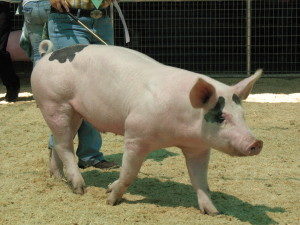 How to Adjust Gain in Show Pigs: Weighing your market hog can be a tense experience, especially when you start counting down the days until the show.
How to Adjust Gain in Show Pigs: Weighing your market hog can be a tense experience, especially when you start counting down the days until the show.
Does the hog weigh too much? Too little? Should you be alarmed by the weight you see on the scale? For example, do you need to adjust the ration to remedy the situation?
Before you make any decisions, take inventory of the situation.
Above all, consider the following questions:
- What is the maximum weight limit at the show?
- How fast has your hog been gaining up to this point?
- Does your show have a weigh back policy?
- What does your pig need in terms of muscle, fat cover and fill?
Use numbers to determine change
The maximum weight limit will tell you how much weight the pig has left to gain. This calculation is a simple one:
(Desired weight (lbs.) – Current weight (lbs.)) / Days remaining until show day = Maximum weight gain per day (lbs.)
For example, let’s use 280 lbs. as the show’s maximum weight, and let’s say you have a 266 lb. pig. There are 30 days left until the show. The calculation would be:
(280 lbs. – 266 lbs.)/30 days=0.47 lbs./day
In this scenario, there is reason for concern. The pig can only gain 0.47 lbs. per day until the show. Additional gain would result in discounts due to size.
To avoid situations like this, weigh your pig regularly on a scale or use a measurement tape to estimate weight . However, if you do find yourself in a situation where you need to slow growth in your show pig, here are some products that can help:
Products to help slow growth in show pigs:
| Product Name | Use | Feeding Rate | Notes |
|---|---|---|---|
| High Octane® Powerfill® Feed | A fully fortified complete feed for swine which meets all the pig's daily nutrient requirements. Can also be used as part of the total diet to 'spike' or concentrate nutrients in the pig's daily diet. | As a complete feed: 3 lbs. per day; as a supplement: 2 lbs. per day with 2 lbs. regular showpig feed. | |
| High Octane® Champion Drive® Topdress | A pelleted (1/8 inch) high protein topdress that helps with muscle development and concentrates nutrients in the pig's daily diet. This product should be used if the pig needs more top shape and muscle definition. | 1 lb. per day, or more as needed. | |
| High Octane® Fitter 35® Supplement | A pelleted (1/8 inch) high protein topdress that achieves everything that High Octane® Champion Drive® Topdress does, but also helps burn fat by diluting the energy content of the pig's daily diet. Should be used on pigs who need more muscle and less fat. This product is handy for trimming up heads and necks. | Replace 2 lbs. of pig's daily diet with 2 lbs. of Fitter 35® Supplement for the final 14-21 days prior to the show. Normal feeding rate is 1 lb. per day. | Can be fed up to 3 lbs. per day as a complete feed to help slow growth (less than 0.5 lbs. per day gain), help increase lean tissue (muscle) and help reduce fat around the head and neck area. |
| High Octane® Heavy Weight® Supplement | A white powder that resembles milk replacer designed to help improve body fat, growth rate and appetite. | To help improve appetite feed 4 oz. per day; to improve fat cover or growth rate feed 8-12 oz. per day. | More can be fed if the pig will consume more without significantly reducing overall daily feed consumption. |
| High Octane® Power Fuel® Supplement | A reddish brown extruded nugget designed to help supply energy in the pig's diet for growth and fat cover, as well as improve feed utilization. | 1/2 to 1 1/2 lbs. per day. | Can be used to complement High Octane® Heavy Weight® Supplement. |
| High Octane® Depth Charge® Supplement | A pelleted (1/8 inch) supplement that expands rapidly after ingestion to help with rib and fill. It is particularly useful when limit feeding to help keep the pig fuller appearing and help take the edge off of appetite. | 1/2 to 1 1/2 lbs. per day. | It is not recommended to wet this product prior to feeding as it begins to expand when it comes into contact with water. If the product expands to an appreciable amount, it may have a negative impact on voluntary feed intake. |
| High Octane® Paylean® Premix | A pelleted (1/8 inch), high protein, fully-fortified supplement that supplies Paylean®. Paylean® has been proven to increase lean tissue, decrease body fat and increase growth rate. The premix also fortified with extra biotin to help pads and Zinpro® zinc methionine to help protect hooves. | 2 oz. per day in 6 lbs. of feed. |
Real-life examples:
There is no one-size-fits-all approach to feeding show pigs. Each pig will likely need its own individual feeding plan.
Below are three common scenarios and feeding program suggestions:
#1 Example: Increasing Pig Gain
#2 Example: Slowing Pig Gain
#3 Example: Stopping Pig Gain
These three examples clearly show that diet formulation varies greatly from animal to animal. A pig that has 1.57 lbs. per day to gain isn’t going to need the same diet as a pig that has 0.47 lbs. per day to gain.
Quick tips for feeding show pigs:
In addition, consider the following additional factors when feeding your show pigs:
- An exhibitor’s ultimate goal is for their pig to look fresh and big-bodied on show day while meeting weight goals. All Purina® Honor® Show pig feeds now include Ambitine® technology formula, an exclusive ingredient that helps support gut integrity and feed intake. Ambitine® technology is a carefully researched blend of plant extracts and acidifiers to help support gut health and essential oils that help stimulate enzyme secretion for feed digestibility.
- Pigs will lose weight on the trailer ride to the show. Most pigs will lose about 6-8 lbs. of gut fill if trailered for 1 or more hours. This weight can be used as a safety net, or it can be added to what the pig can gain per day.
- Further, pigs utilize feed differently, and on specific diets some pigs may gain a little faster or a little slower. Weigh your pigs often and know what they’re gaining. Adjust accordingly.
- Mixing feed with water to make a moist paste will help the pig eat faster.
- If pigs are slow to adjust and eat High Octane® Powerfill® (very different in taste and texture as compared to pelleted feeds).
- Energy (calories) fuels growth. The higher the energy content of the diet, the faster the pigs will grow. To reduce growth rate, reduce energy content by adding High Octane® Champion Drive® or High Octane® Fitter 35® supplements to the daily feed.
- 25 grams per day lysine is the magic number for pigs weighing 200 lbs. or more. If feeding very low daily feeding rates, as long as 25 grams per day is provided to the pig, it should not lose muscle.
- Feed the pig in two equal meals per day as evenly spaced as possible. Feed at the same times every day. The more consistent, the better.
- Likewise, exercise will help burn calories intended for growth. Exercise during the coolest part of the morning or evening to help pigs stay on schedule.
Remember that your pig has to look its best in the show ring. Knowing your pig’s weight, taking time to adjust diets as needed, and making sure you’re using a high quality feed program are all essential to finding yourself in front of the backdrop.
In conclusion, Kissimmee Valley Feed has a great selection of Show Feeds to help you raise a champion!





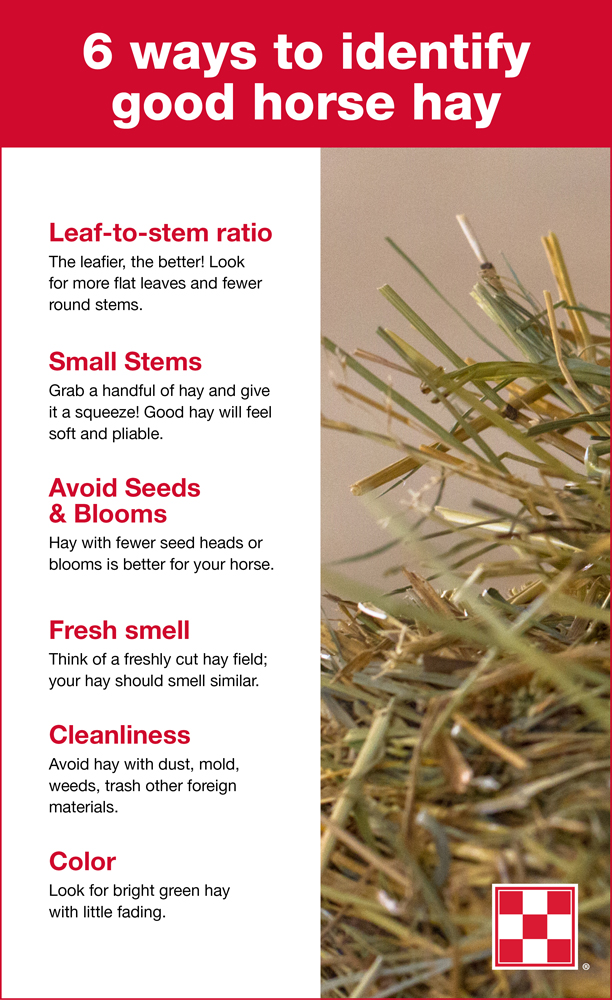 Forage makes up between 50 and 90 percent or more of a horse’s diet. Much of the forage part of the diet comes in the form of hay. Because it’s such a big part of the ration, a good quality hay can help keep a horse healthy, while a poor quality hay can be detrimental. This is why, as nutritionists and horse owners, we put a big emphasis on the quality of hay we feed.
Forage makes up between 50 and 90 percent or more of a horse’s diet. Much of the forage part of the diet comes in the form of hay. Because it’s such a big part of the ration, a good quality hay can help keep a horse healthy, while a poor quality hay can be detrimental. This is why, as nutritionists and horse owners, we put a big emphasis on the quality of hay we feed.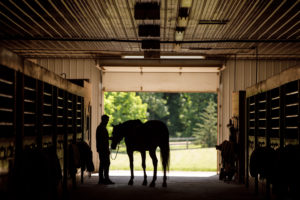 Fat is important for performance horses. The use of fat in the equine diet has a long history. A very old book, Horse Secrets by A.S. Alexander, published in 1913, points out that horse traders knew back then that adding fat to the diet was beneficial for gaining weight and improving hair coat. They may not have known why it worked, but they knew that it worked!
Fat is important for performance horses. The use of fat in the equine diet has a long history. A very old book, Horse Secrets by A.S. Alexander, published in 1913, points out that horse traders knew back then that adding fat to the diet was beneficial for gaining weight and improving hair coat. They may not have known why it worked, but they knew that it worked!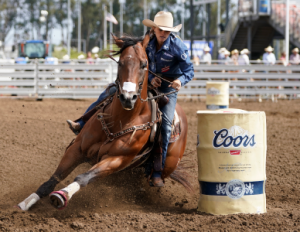 Concern for performance horses and muscle recovery may be the difference between a win and a loss. In various disciplines speed, strength, collection and stamina all play into the difference between earning a big paycheck and awards or going home empty handed.
Concern for performance horses and muscle recovery may be the difference between a win and a loss. In various disciplines speed, strength, collection and stamina all play into the difference between earning a big paycheck and awards or going home empty handed.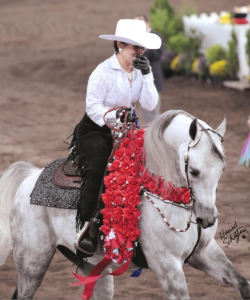 Managing feeding programs on the road for show horses is a necessary skill. The show season is in full swing. Subsequently, horses are subjected to the stress of going down the road on a regular basis. This travel schedule imposes additional requirements for managing the feeding program.
Managing feeding programs on the road for show horses is a necessary skill. The show season is in full swing. Subsequently, horses are subjected to the stress of going down the road on a regular basis. This travel schedule imposes additional requirements for managing the feeding program.